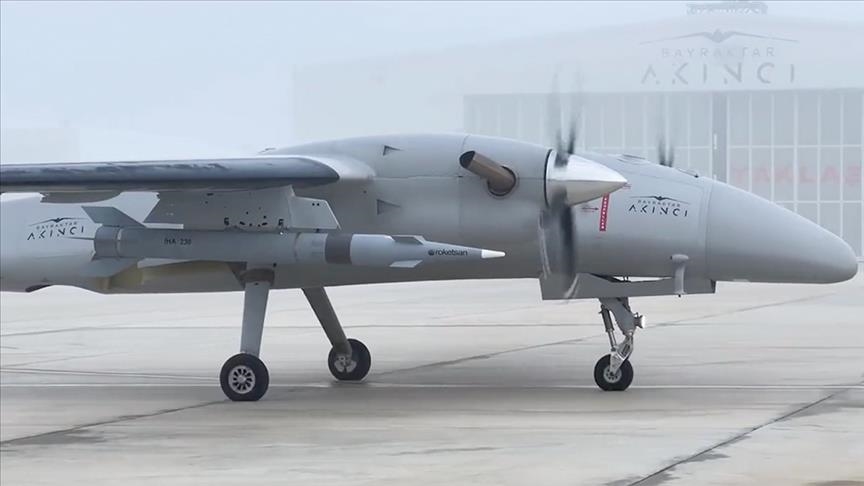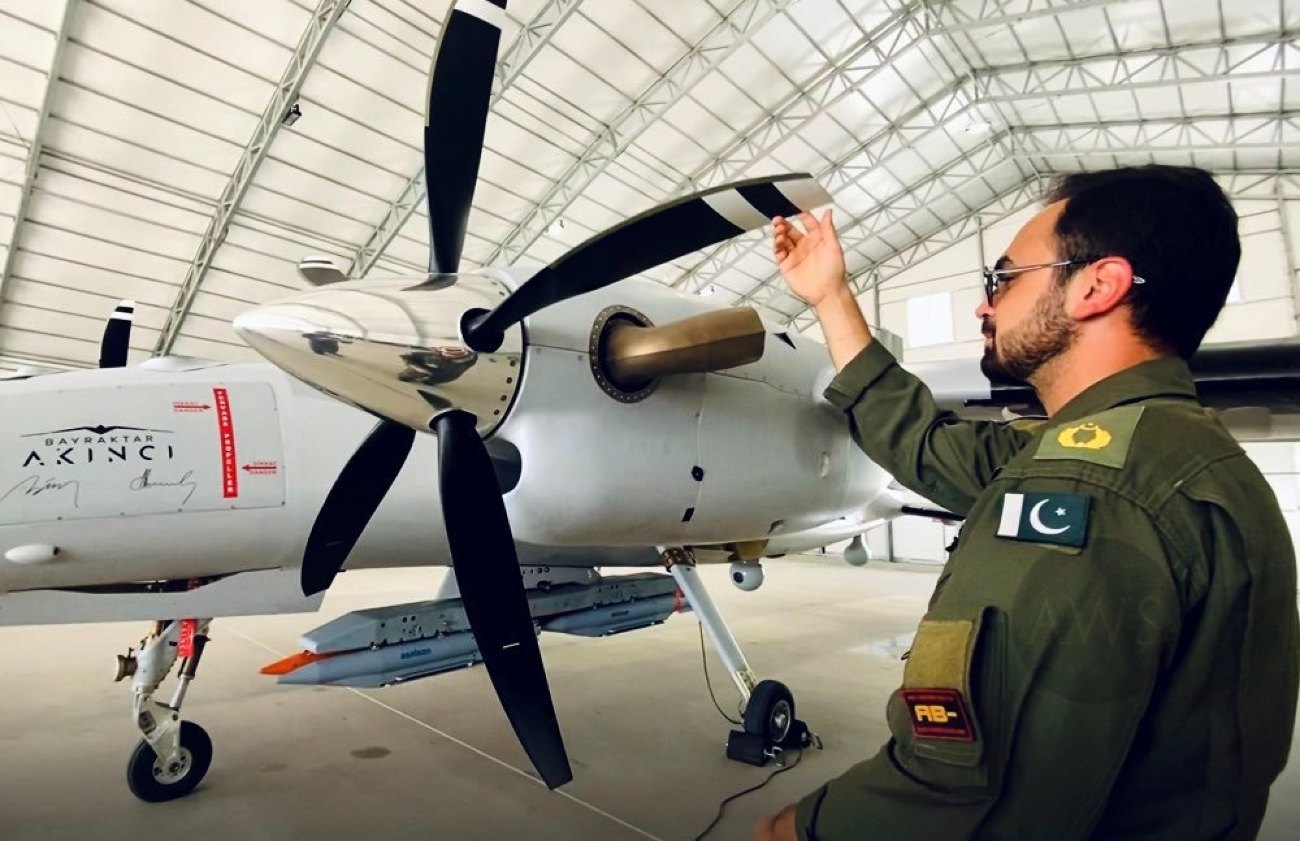Turkey’s Akinci unmanned combat aerial vehicle (UCAV) has test-fired an air-to-ground/air-to-surface missile (AGM/ASM), the first in the country that can fly at “supersonic” speeds. It is designed to counter targets like tactical battlefield command centers, bunkers, logistics nodes, and light armored vehicles.
However, an interesting feature of the missile visible in the launch video is the rotating rear fins near the exhaust, presumably to stabilize the munition in flight by preventing it from ‘rolling.’
The action is caused by airflow around the missile’s length that makes the fins rotate, spinning on a loose tail-end section, possibly on ball bearings. These control surfaces have been identified as rollerons, with their variations seen on older US and Russian air-to-air missiles.
The Missile & its Features
A report from the state-run news agency headquartered in Ankara, Anadolu Agency, identified the missile as the IHA-230, capable of hitting targets at a distance of 140 km (90 miles).
The test was conducted at the Sinop Firing Range in the Black Sea. The Akinci is a product of Turkish drone and aerospace major Baykar, while the IHA-230 has been developed by missile and munition giant Roketsan.
It would be pertinent to note that Pakistan too, is a user of the Akinci UCAV, acquiring the first six to seven such units of the High-Altitude Long-Endurance (HALE) drone in April 2023. Reports suggest Islamabad is likely to buy more such platforms in the coming years.

The missile was first test-fired on December 16, 2022, with the Akinci at an altitude of 7.6 km, according to Selcuk Bayraktar, Baykar’s chief technology officer (CTO). The second test took place more than three months later, around April 2023.
The IHA-230 destroyed a target in the Black Sea at a distance of 140 km, with the Akinci taking off from the Flight Training and Test Centre. The missile was launched as the drone approached the Sinop province.
The successive tests indicate Rokestan has been examining different features of the missile, ranging from carriage and release mechanisms, propulsion, warhead efficiency, and guidance and navigation.
Tactics
The IHA-230 (also called the UAV-230), according to Roketsan, can operate in “day and night” conditions and is “effective against stationary land and sea targets, air defense radar and communication systems, light armored land or sea vehicles, critical facilities such as command centers, personnel, and targets of opportunity.”
The “operational range” of over “150 km” is, however, dependent “on the speed and altitude at which the missile is released.”
It primarily uses a “fragmentation warhead” (or blast fragmentation warhead as it is commonly known), but can also be installed with other “different versions against different target types”.
“The system is readied for its mission after completion of the firing preparation process before leaving the UAV. After being released from the UAV, it falls freely in the air for a certain period and autonomously ignites the solid fuel engine,” Roketsan adds. In other words, target coordinates and locations are loaded into the missile’s navigation and guidance system on the ground before launch.
Baykar Akinci conducted an IHA-230 Supersonic Missile Firing Test 🇹🇷 pic.twitter.com/TWYchv0sIO
— Global Defense Insight (@Defense_Talks) March 2, 2024
This implies that the operators would not want to risk putting the Akinci in harm’s way by initiating complex target acquisition and engagement procedures during flight since that might give enemy air defense missiles significant time to locate and hit the drone.
This also means the firing will be preceded by extensive surveillance and reconnaissance of the target area to identify targets before the Akinci is pressed into action with the IHA-230. The data will then be analyzed to select locations or enemy ground assets to be struck.
“The UAV-230 is guided precisely to the target thanks to its GNSS-supported inertial guidance capability, which provides a countermeasure against jamming systems. The system functions with a fire-and-forget capability. It allows the user to use it for critical missions without infiltrating deep into enemy positions,” Roketsan said, validating the prior analysis.
Such platforms significantly take the load off other aerial strike platforms like the Turkish ATAK attack helicopters or US-origin F-16s, allowing them to perform riskier missions like battlefield interdictions or strategic ground strikes.
The mention of “air defense radar and communication” systems by Roketsan as potential targets also means the IHA-230 can be used for Suppression/Destruction of Enemy Air Defense (SEAD/DEAD) roles to clear the path for larger manned fighters and helicopters.
Rotating Fins
The video released by Baykar and Roketsan showed one of the ground crew members rotating the section of the rear part near the exhaust on which the tail fins are mounted. The fins on the IHA-230 are then seen rotating around the central axis when the Akinci is in flight.
Baykar Akinci conducted an IHA-230 Supersonic Missile Firing Test 🇹🇷 pic.twitter.com/TWYchv0sIO
— Global Defense Insight (@Defense_Talks) March 2, 2024
The missile then hits an unidentified target in a thermal image view of an electro-optical system, followed by a standard CCD camera view of the disturbance in the water after the hit. While the missile is in motion through the air, the resulting air current generated causes the rolleron to rotate.
Russian Strela-10 air defense missiles and the US AIM-9 Sidewinder use a version of the rolleron where a metal flywheel is positioned at the trailing end of the tail fin.
While spinning, the flywheel resists any lateral forces acting on it, similar to a gyroscope. The IHA-230, however, has the entire outer body near the exhaust rotate sideways with the fins firmly in place, giving greater stability during straight-line flights.

Akinci in Use with Pakistan
It is not clear if the IHA-230 will also be sold to Pakistan for the Akincis in service with the Pakistan Air Force (PAF) or if Islamabad has expressed interest in the missile. It is also not clear if the IHA-230 can be used by other aerial strike platforms in the Turkish Air Force inventory.
However, PAF’s possession of the drone does mark a significant shift in the balance of tactical military dynamics between India and Pakistan. Reports say that the first six to seven Akincis delivered to Pakistan in April 2023 belonged to the ‘A’ variant (Akinci-A), with subsequent deliveries likely to be of the more advanced Akinci-B.
But even with the Akinci-A, the Pakistan Air Force currently maintains a “decisive advantage in fulfilling its long-range reconnaissance and surveillance objectives within the region, primarily attributable to the operational deployment of Bayraktar Akinci drones,” said a report from the International Center for Peace Studies (ICPS).
- The author can be reached at satamp@gmail.com
- Follow EurAsian Times on Google News




